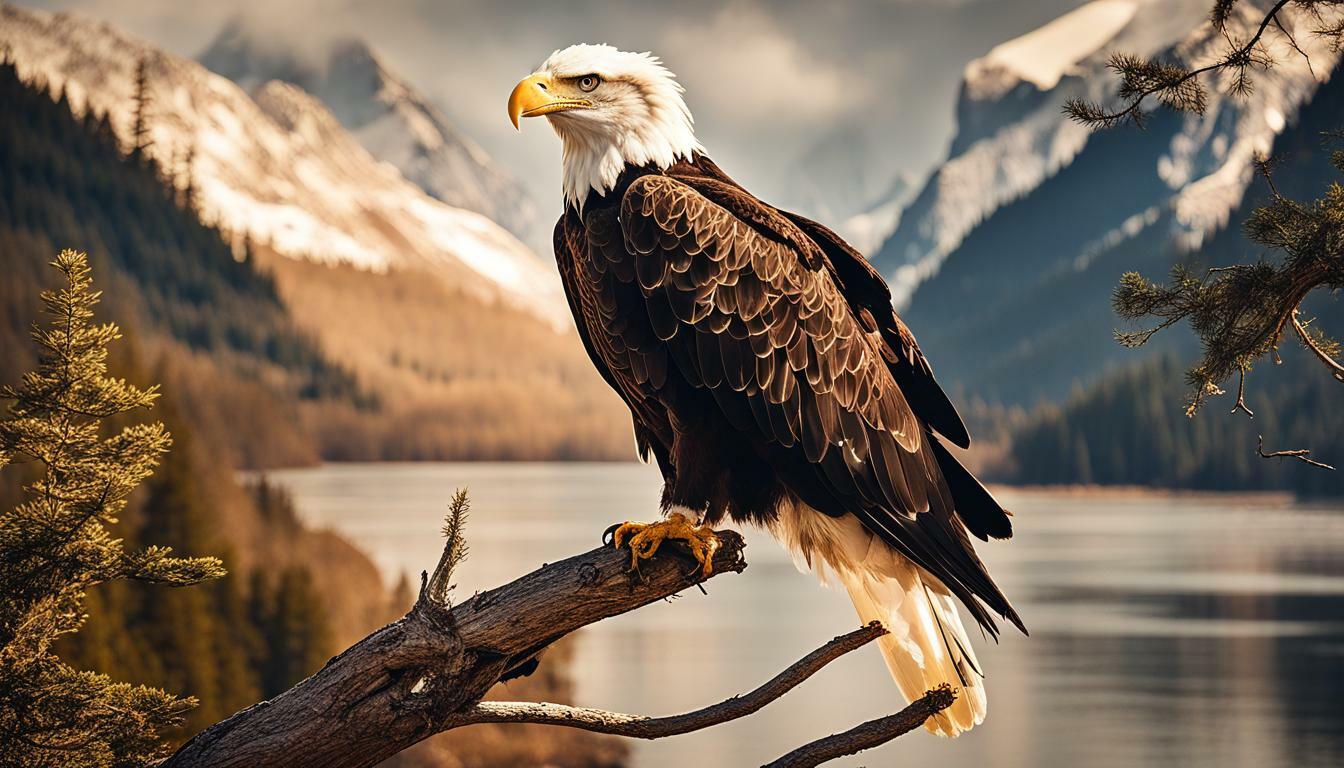When you think of bald eagles, you likely picture their iconic white heads. But do female bald eagles also have this distinctive coloring? In this section, we will explore the appearance and characteristics of female bald eagles to answer this question.
Key Takeaways:
- Females bald eagles do not typically have white heads like their male counterparts.
- The plumage and physical features of female bald eagles play important roles in their identification and overall beauty.
Bald Eagle Female Characteristics
Female bald eagles, also known as bald eagle females, have a distinct appearance that sets them apart from their male counterparts. While both males and females have a similar overall body structure and plumage, there are a few key differences to take note of when identifying a female bald eagle.
One of the most notable differences is their size. Female bald eagles tend to be larger than males, with a wingspan that can reach up to 7 feet. This size difference is known as sexual dimorphism and is common in many bird species.
Another difference is in their beak structure. Females have a slightly deeper and broader beak than males, which is due to their larger size and the need to be able to catch and handle larger prey.
The plumage of female bald eagles also differs somewhat from that of males. They have the same distinctive white head and tail feathers, but their body feathers are generally darker and less mottled. Some female bald eagles may also have a faint band of white feathers on their lower wings which can be used to help distinguish them from males.
Overall, the appearance of female bald eagles is similar to that of males, but with a few key differences in size, beak structure, and plumage. These differences can be helpful in identifying individual birds and understanding their roles within the species.
The Head Coloration of Female Bald Eagles
Female bald eagles are renowned for their impressive size and striking appearance. However, many people are curious about whether female bald eagles have white heads like their male counterparts. While male bald eagles are known for their iconic white heads and tails, female bald eagles have a different head coloration.
Female bald eagles typically have darker head feathers than males, with a brownish-black coloration. However, there can be variations in the head feathers of female bald eagles, with some birds displaying lighter feathers or even a slight white patch on their heads. These variations can make it challenging to identify female bald eagles based on their head coloration alone.
The head feathers of female bald eagles also differ from those of males in terms of size and shape. Female bald eagles have shorter head feathers than males, with less pronounced crests and a slightly rounded appearance. Additionally, their head feathers are often fluffier and more compact than those of males.
The head coloration of female bald eagles can also vary depending on age and environmental factors. Juvenile female bald eagles, for example, may have lighter or mottled head feathers, which gradually darken as they mature. Similarly, female bald eagles that live in areas with high levels of pollution may display a yellowish or grayish tint to their head feathers.
Female bald eagles use their distinctive appearance and plumage to attract mates and signal their status within the species. While they may not have the same white heads as males, female bald eagles are still awe-inspiring creatures that play a vital role in the ecosystem.
The Plumage of Female Bald Eagles
Female bald eagles have distinct physical characteristics that differentiate them from their male counterparts. One of the most notable differences is their plumage. While male bald eagles have a white head and tail feathers, female bald eagles have a darker head and a mottled brown and white body.
Their plumage coloration varies depending on their age. Juvenile female bald eagles have a mostly brown plumage, with the head and tail feathers being darker than the rest of their body. As they age, their plumage begins to lighten, with a mix of brown and white feathers on their body.
Their flight feathers also have distinct patterns. The primary feathers on their wings have white undersides, while the secondary feathers are mostly dark brown. This coloration pattern makes it easy to identify female bald eagles in flight.
Female bald eagles have a darker head and a mottled brown and white body.
The plumage of female bald eagles is not just for display. It plays a crucial role in mate selection and breeding. Males will often choose a mate with healthy plumage, as it is an indicator of good health and genetic fitness.
In addition, the plumage of female bald eagles serves a practical purpose in their everyday life. The brown and white coloration provides camouflage in their natural habitat, allowing them to blend in with their surroundings and avoid detection from predators.
In conclusion, the plumage of female bald eagles is a unique and essential aspect of their appearance and biology. Their mottled brown and white coloration, distinct patterns on their flight feathers, and role in mate selection and breeding make them a fascinating species to observe and study.
Understanding Bald Eagle Gender Differences
If you’re interested in learning more about the impressive bald eagle species, then understanding their gender differences is a great place to start. While male bald eagles are typically smaller in size, female bald eagles are larger, with longer wingspans and larger beaks. This is a key distinguishing feature that can help you identify female bald eagles in the wild.
In addition to size differences, there are also behavioral differences that can be observed between male and female bald eagles. Female bald eagles are often the primary caretakers of their young, while males are responsible for hunting and providing food for the family. This division of labor is important for ensuring the survival of the species and can be fascinating to observe in the wild.
It’s important to note that female bald eagles also differ in appearance from their male counterparts. While male bald eagles have iconic white heads and tails, female bald eagles have mottled brown and white plumage with dark tail feathers. This can make it easier to identify male bald eagles, but it’s equally important to recognize the unique beauty of female bald eagles.
Overall, understanding bald eagle gender differences can deepen your appreciation for these magnificent birds and enhance your birdwatching experiences. Whether you’re observing their behavior in the wild or simply admiring their physical features, both male and female bald eagles offer unique insights into the natural world.
Factors Influencing Bald Eagle Head Color
The head coloration of female bald eagles can vary depending on a variety of factors. Here are some of the most common factors that influence their head color:
| Factor | Description |
|---|---|
| Genetics | The genes passed down from the female’s parents can impact the color of her head feathers. Some genetic variations can cause female bald eagles to have more white feathers on their head, while others can result in darker, more uniform head coloration. |
| Environmental Factors | The environment that a female bald eagle lives in can also impact the color of her head feathers. For example, eagles that live in areas with more sunlight may have lighter, more bleached head feathers, while eagles that live in areas with more shade may have darker feathers. |
| Age | The age of a female bald eagle can also impact the color of her head feathers. Older eagles may have more white feathers on their head, while younger eagles may have more mottled or speckled head coloration. |
In addition to these factors, female bald eagles may also exhibit some individual variation in their head coloration. This can make it difficult to identify female eagles based solely on their head color.
Overall, while female bald eagles do not typically have white heads like their male counterparts, their head coloration can be influenced by a variety of factors, highlighting the diversity and complexity of these magnificent birds.
Other Physical Characteristics of Female Bald Eagles
Aside from their head coloration and plumage, female bald eagles have other notable physical characteristics that distinguish them from male eagles. One key difference is their size, with females typically larger than males. Female eagles also tend to have longer wingspans, measuring up to 7 feet in some cases. Their beaks are also larger and more robust, which enables them to hunt and eat larger prey.
Another interesting physical characteristic of female bald eagles is their eye color. While both male and female eagles have bright yellow eyes, the eyes of female eagles tend to be slightly darker and more vibrant.
The overall appearance of female bald eagles is impressive and captivating. Their dark brown plumage provides excellent camouflage as they soar through the sky, and their distinctive white tail feathers catch the eye as they hunt or glide through the air.
Conclusion
In conclusion, the question of whether female bald eagles have white heads has been explored in detail. While male bald eagles are known for their distinctive white heads, female bald eagles typically do not have white heads, but rather a darker and more mottled appearance. However, the head coloration of female bald eagles can vary based on genetic, environmental, and age-related factors.
Beyond their head coloration, we have gained a deeper understanding of the appearance and characteristics of female bald eagles. Their plumage, size, beak structure, and eye color are all notable features that play a role in their identification and overall beauty.
Whether you are a bird enthusiast or simply curious about these majestic creatures, understanding the physical characteristics and behaviors of female bald eagles can be a fascinating topic to explore. So, the next time you see a bald eagle soaring through the sky, take a closer look and see if you can identify whether it’s a male or female. And remember, while the white head may be a hallmark of male bald eagles, the mottled beauty of female bald eagles is just as striking in its own way.
Do Male Bald Eagles Attack Humans More Often than Females?
Understanding eagle behavior in the us helps shed light on whether male bald eagles attack humans more frequently than females. While both genders can exhibit aggressive behavior when defending their territories, there is no evidence to suggest a gender-based preference for attacking humans. Rather, such instances are rare and often occur when eagles perceive a threat. With a deeper comprehension of eagle behavior, we can continue to coexist safely with these majestic creatures.
FAQ
Q: Do female bald eagles have white heads?
A: No, female bald eagles do not typically have white heads like their male counterparts. Their head coloration can vary.
Q: What are the characteristics of female bald eagles?
A: Female bald eagles have a similar appearance to male bald eagles. They are large birds with a wingspan of up to 7 feet and a body length of around 3 feet. They have a dark brown body and wings, with a white head and tail. However, their head coloration can vary.
Q: What is the plumage of female bald eagles like?
A: The plumage of female bald eagles is similar to that of males. They have a dark brown body and wings, with a white head and tail. However, variations in their head coloration can occur.
Q: How can I identify a female bald eagle?
A: Female bald eagles can be identified by their large size, dark brown body and wings, and white head and tail. However, it is important to note that their head coloration can vary.
Q: What factors may influence the head coloration of female bald eagles?
A: The head coloration of female bald eagles can be influenced by genetic, environmental, and age-related factors. These factors can contribute to variations in their head color.
Q: What are some other physical characteristics of female bald eagles?
A: In addition to their head coloration, female bald eagles are known for their large size, hooked beak, and yellow eyes. Their plumage and physical features contribute to their overall beauty.











